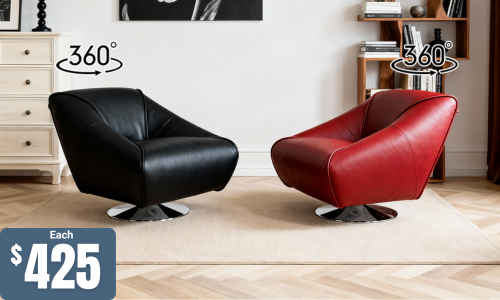Posts tagged with 'material choices'
 In the realm of design, where creative boundaries are boundless, fashion and furniture have long been kindred spirits. The allure of aesthetics, the significance of functionality, and the influence of cultural trends meet at this intriguing crossroads, fostering a captivating interplay that perpetually inspires innovation. This article delves into the enthralling relationship between fashion and furniture design, exploring how they mutually influence and enrich each other's domains.
In the realm of design, where creative boundaries are boundless, fashion and furniture have long been kindred spirits. The allure of aesthetics, the significance of functionality, and the influence of cultural trends meet at this intriguing crossroads, fostering a captivating interplay that perpetually inspires innovation. This article delves into the enthralling relationship between fashion and furniture design, exploring how they mutually influence and enrich each other's domains.
A Fusion of Form and Function:
Both fashion and furniture design share a fundamental principle: the fusion of form and function. Just as a finely tailored suit makes a statement whilst ensuring comfort, furniture must blend style and utility seamlessly. Designers in both disciplines face the challenge of crafting pieces that are not only visually appealing but also practical in everyday life.
Material Choices:
One of the most conspicuous links between fashion and furniture design resides in the selection of materials. The textures, colours, and fabrics used in clothing frequently find their way into furniture upholstery, culminating in a harmonious marriage. Luxurious velvet sofas, sleek leather chairs, and fabric-draped headboards all acknowledge fashion for their material inspirations.
Colour Trends and Palettes:
Fashion designers frequently dictate colour trends that extend far beyond the catwalk. The hues showcased in clothing collections inevitably impact the colour palettes chosen for furniture upholstery and finishes. As fashion trends transition from earthy neutrals to bold, vibrant shades, furniture designers follow suit, crafting pieces that align with contemporary tastes.
Cultural Impacts:
Both fashion and furniture design draw richly from cultural influences. Designers frequently incorporate motifs, patterns, and artistic elements from various cultures into their creations. Whether it's the influence of Japanese minimalism or the vibrancy of African prints, this cross-pollination of ideas enriches both industries and allows consumers to experience diverse global aesthetics.
Evolving Styles and Eras:
In the same vein as fashion's distinct eras – such as the Roaring Twenties, the Swinging Sixties, and the minimalist Nineties – furniture design also mirrors these stylistic shifts. Mid-century modern furniture, for example, reflects the clean lines and functional elegance of its era, much like the fashion trends of that period. The fluidity between these two domains ensures that past styles consistently inspire contemporary design.
The convergence of fashion and furniture design represents an enthralling realm where creativity knows no bounds. As these two fields continue to inspire and influence each other, we can anticipate witnessing even more innovative designs that cater to our ever-evolving tastes and requirements. Therefore, the next time you embark on a quest for a stylish sofa or a trendy outfit, remember that you're not merely selecting a piece of fabric or furniture – you're embracing a rich tapestry of design history and culture.

Furniture design is an art that goes beyond mere functionality. It is an intricate dance between aesthetics, utility, and psychology. The shapes and forms of furniture have a profound impact on our emotions and well-being, shaping our experiences within a space. In this article, we delve into the fascinating realm of the psychology of furniture design, exploring how different shapes and forms can influence our emotions and create meaningful connections with our surroundings.
The Power of Shapes
Shapes play a crucial role in influencing our emotions and perceptions. In furniture design, various shapes can evoke different feelings and responses. For instance:
- Curves and Soft Edges: Furniture with curvilinear forms and soft edges often elicits feelings of comfort, warmth, and relaxation. These shapes are reminiscent of natural forms and human bodies, creating an inviting and soothing atmosphere.
- Rectangles and Straight Lines: Furniture featuring clean lines and geometric shapes exudes a sense of order, stability, and professionalism. Rectangular forms are often associated with efficiency and precision, making them suitable for office and workspace design.
- Organic and Irregular Shapes: Furniture with irregular or asymmetrical forms can spark creativity and intrigue. Such designs can break away from conventional norms, encouraging a sense of uniqueness and exploration.
Forms that Evoke Emotions
Beyond shapes, the overall forms of furniture pieces can also elicit specific emotional responses:
- Cocooning and Nesting: Furniture designs that envelop the user, such as lounge chairs with high backs or canopy beds, create a feeling of security and privacy. These forms are reminiscent of shelter and protection, appealing to our primal instincts.
- Open and Airy: Furniture that employs open forms, such as open-back shelving units or minimalist coffee tables, promotes a sense of spaciousness and freedom. These designs can reduce feelings of clutter and confinement, contributing to a more relaxed environment.
- Dynamic and Movement: Furniture designs that incorporate elements of movement, such as swivel chairs or rocking chairs, encourage a sense of playfulness and engagement. These forms can stimulate our senses and foster a lively atmosphere.
Colour and Material Influences
While shapes and forms are paramount, colour and material choices in furniture design further enhance the emotional impact. Cool tones like blues and greens can evoke a sense of tranquillity, while warm tones like reds and yellows can infuse energy and positivity. Similarly, materials like natural wood can bring warmth and authenticity, while metals and glass can create a modern and sophisticated ambiance.
Cultural and Contextual Considerations
The psychology of furniture design is not limited to universal responses; cultural and contextual factors also play a significant role. Different cultures associate various shapes and forms with distinct meanings. Additionally, the purpose of the space and the intended user experience should be considered when designing furniture that resonates emotionally.
In the world of furniture design, shapes and forms are more than aesthetic choices; they are powerful tools that shape our emotions and experiences. Whether it's the cosy embrace of a curved sofa, the structured efficiency of a rectangular desk, or the playful movement of a swivel chair, each design decision influences our well-being and how we connect with the spaces we inhabit. By understanding the psychology behind furniture design, we can create environments that not only serve a functional purpose but also enrich our lives on a deeper, emotional level.




.jpeg)

 (3).jpeg)
